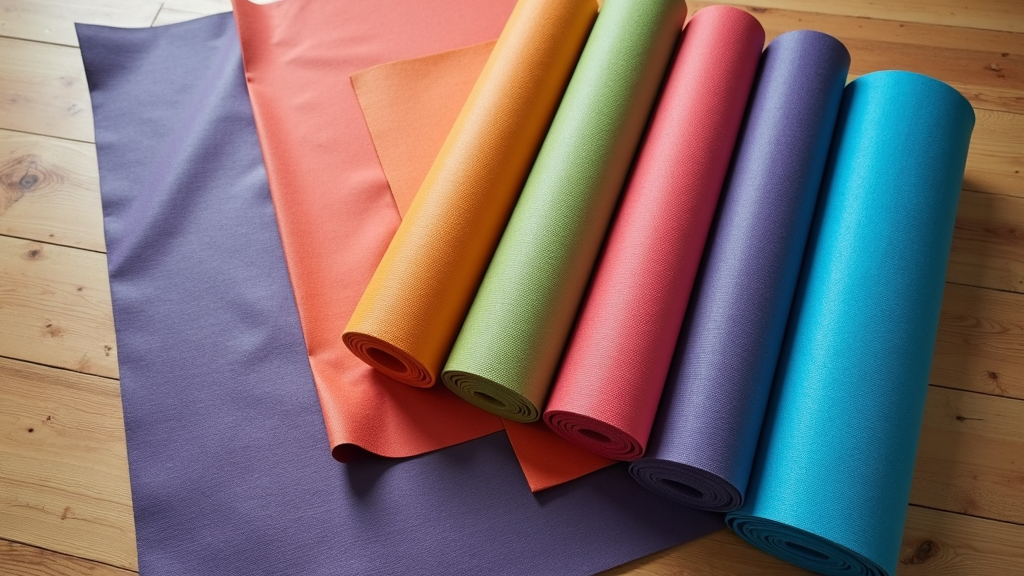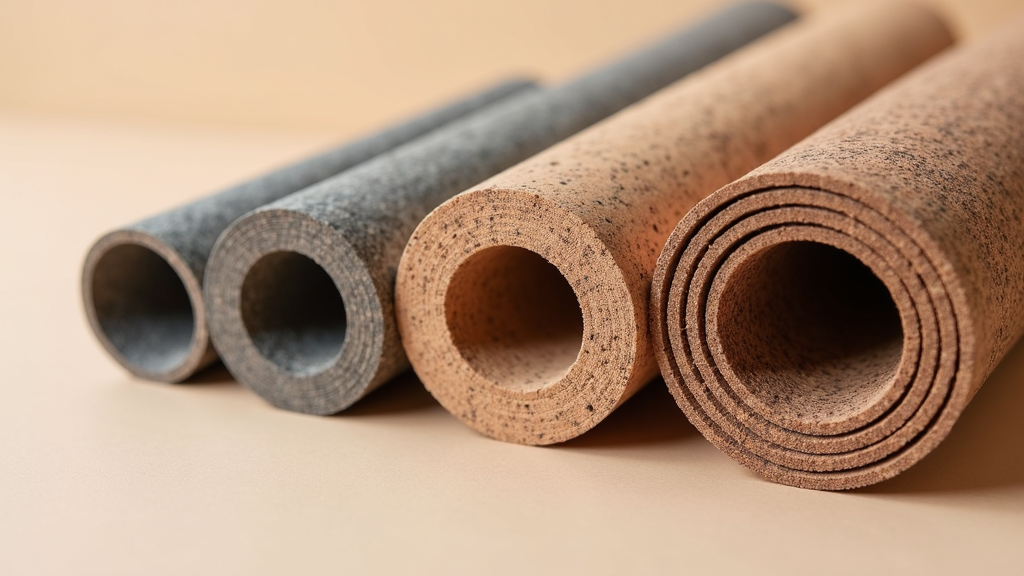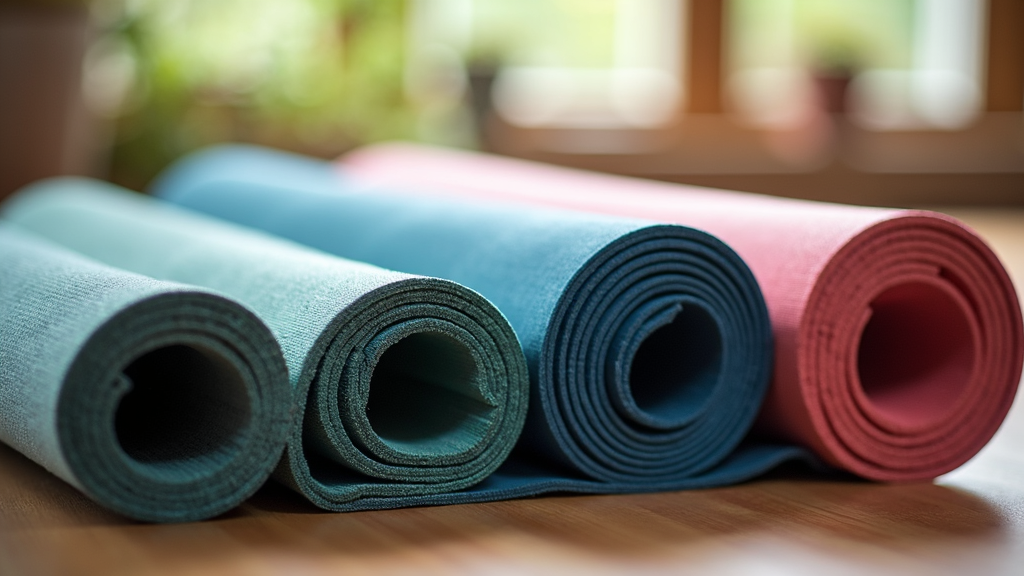Searching for the best yoga mat can feel overwhelming, especially with so many brands, styles, and price points out there. I’ve put down a serious amount of time (and sweat) on dozens of mats, and I’ve found that the right choice depends heavily on what matters most to you: grip, cushioning, eco friendliness, durability, weight, or even something as simple as the colour and texture beneath your feet. So, here’s an all-in-one look at who makes the best yoga mats, what brands are worth your money, and how to actually pick the one that fits your practice perfectly.
Before jumping in, here’s a quick overview of my top picks, plus more details that’ll help you figure out what matters most for your mat.

Top Yoga Mat Brands: Manduka, Liforme, Jade Yoga, Gaiam, Lululemon
Typical Price Range: £18.00–£130
Materials: PVC, natural rubber, TPE, cork, and more
Thickness Options: 1mm (travel) to 8mm (extra plush)
Best For: All levels, from new yogis to seasoned teachers
Which Brand Is Good for Yoga Mats?
Sorting through the dozens of brands, a handful have strong reputations for blending grippy textures, solid support, and durability. I’ve used each of these at some point and can easily say they’re reliable, popular worldwide, and get mentioned by instructors everywhere.
- Manduka: Manduka mats are pretty much an industry standard among yoga teachers. Their PRO series stands out for dense support and longevity. These are made for heavy use and feel super stable underfoot.
- Liforme: If alignment and eco friendly materials matter, Liforme is definitely worth checking out. Their mats have etched guides to help with hand and foot placement, and they offer a really grippy, plant based rubber surface.
- Jade Yoga: Jade mats are all about eco values. Their natural rubber construction delivers fantastic grip, especially when the room gets sweaty. Plus, they plant a tree for every mat sold, which is next-level cool.
- Gaiam: Gaiam makes lightweight, budget friendly mats that work well for beginners. They may not last as long as the pricier brands but are easy to find and come in loads of design options.
- Lululemon: Their Reversible Mat is very popular in the yoga crowd. It’s known for strong grip on both sides and feels just a bit softer than other premium mats. If you sweat a ton, this is one to consider.
Other brands have carved out smaller niches. Think Yoloha with cork mats, or Hugger Mugger for luxe, thick styles. If you have a local yoga studio, it’s always worth asking what brands they use for borrow mats. That can be a good way to test before you commit.
What Is the Best Mat to Use for Yoga?
The word “best” gets used a lot in yoga mat reviews. Honestly, it comes down to what you need for your practice. Some mats shine in heated classes, others are made for gentle restorative sessions. Here’s what to think about before making a pick.
Grip and Traction
I can’t count how many times a slippery mat has killed my focus. That’s why strong grip, especially when sweaty, is near the top of my list. For ultimate traction, Liforme and Jade Yoga both deliver, even as the workout heats up. Lululemon’s Reversible Mat is also reliable if you alternate between hot and regular classes, with smooth and textured sides to choose from.
Cushioning and Support
If joint pain is an issue or you prefer a little extra padding for seated or kneeling poses, Manduka’s PRO series is tough to beat for thickness and support. These mats provide plenty of comfort but still feel dense enough for balance.
Ecofriendliness
More and more, yogis want mats that avoid harsh chemicals and won’t end up in a landfill for decades. Jade Yoga and Liforme are the leaders here, using natural tree rubber and sustainable practices, and both are PVC free. Yoloha goes a step further with mats made of cork and recycled rubber for those wanting something directly from nature.
Easy to Carry
If you’re always on the go or need something for travel, Manduka’s eKO Superlite or Gaiam’s travel mats are super thin (about 1–2mm), folding or rolling up into a bag pocket. You sacrifice a bit of cushion, but convenience is on your side.
Price vs. Performance
It’s totally possible to get a good mat for less, especially from Gaiam or BalanceFrom. Expect to replace budget mats more often though, as they can wear down quickly or start to peel. If you want something for daily use that’ll last for years, shelling out for a Manduka or Liforme makes sense, as these brands often come with long warranties.
Does an Expensive Yoga Mat Make a Difference?
I’ve owned both £16 mats and $110 mats. The difference comes down to feel, durability, and confidence. Pricier mats like the Manduka PRO or Liforme almost always last longer. They stay grippy, don’t flake, and keep their shape, which matters if you practice regularly.
The “expensive mat” debate gets even clearer once you start practicing several times a week. Cheaper mats might start to lose their grip, develop wear spots, or pick up funky smells after daily use. Investing in a quality mat can save you money over time, plus you’ll enjoy your practice more.
- Longevity: Higher end mats can last 5–10 years with regular use.
- Warranty: Brands like Manduka offer lifetime guarantees against wear through normal practice.
- Performance: Premium mats are more likely to keep their grip and density, especially with proper care and cleaning.
That said, if you’re new to yoga and just want to try it out, there’s really no shame in starting with a budget mat, especially if you’re unsure you’ll stick with it. Just remember, you may be looking to upgrade if you become a regular.
What Thickness of Yoga Mat Is Best?
Yoga mat thickness isn’t about one size fits all solutions. The standard mat thickness is right around 4–5mm (3/16 inch), which for me offers a balance of comfort and stability. Here’s a breakdown so you can pick what works:
- 1–2mm (Travel Mats): Ultra thin, easy to carry, but not cushy. Great for trips and hotel room flows. Example: Manduka eKO Superlite.
- 3–5mm (Standard): The sweet spot for most yogis. Enough cushion for comfort, thin enough for stability in balancing poses. Liforme, Manduka PROlite, and most mainstream mats fall right here.
- 6mm+ (Plush/Supportive): Extra support for sensitive joints or restorative/yin yoga. Sometimes these thicker mats can be harder to balance on, especially for standing poses, but great if comfort is your top priority. Manduka PRO is a goto in this range.
If you’re mostly practicing power yoga or flow styles with lots of transitions, stick to the midrange (3–5mm) mats for reliable footing. If your knees give you trouble or you do more gentle/restorative yoga, a cushier (6mm+) mat can really help. And if you’re tight on packing space, the ultra thins are pretty handy travel companions.
How to Choose a Yoga Mat: What Really Matters
The number of yoga mats on the market is wild. There are literally thousands of options. But having tested a bunch in studios, at home, and while teaching, I’ve realised that certain features matter more than others. Understanding what you want from your mat helps narrow things down fast.
Key Features To Consider
- Grip: Go for a mat that’s sticky enough for your hands and feet to stay put, even in sweaty conditions.
- Material: Natural rubber gives better traction, while PVC mats tend to be more durable but are less eco friendly. TPE and cork are good for folks with latex allergies or a focus on sustainability.
- Portability: If you travel often, look for a mat that rolls tightly or folds, with a manageable weight (under 3 lbs is handy).
- Durability: If you do yoga daily or leave your mat in the car or studio, tougher mats like Manduka PRO, Jade Harmony, or Liforme are worth the upfront cost.
- Easy Care: Mats that can be wiped down quickly or washed easily score bonus points. Natural rubber cleans up with just a few spritzes!
- Eco friendly: If sustainability is on your radar, seek out natural materials, OEKO TEX certifications, or brands with solid earthfriendly policies.
- Price: Be honest about your budget, but remember sometimes cheap means replacing the mat frequently.
Adding Personality
Color and style might not be the most important things, but they definitely help you look forward to unrolling your mat. Some brands offer unique prints or textured designs. Gaiam and Yoga Design Lab stand out for prints, while companies like Manduka stick with solid colours.
Comparing Top Yoga Mat Brands
Each leading yoga mat brand has its own set of loyal fans. Some are better for power yoga and sweaty classes, while others cater to restorative practices and meditation. Here’s my take on the best yoga mats from the top brands, including what makes each special, plus some pros and cons.
Manduka Yoga Mats
Manduka PRO: This mat gets recommended by instructors everywhere. At 6mm thick, it offers cushion without feeling spongy. It can take a few sessions to “break in” for max grip, but it honestly lasts for years. It’s a bit heavier to carry (around 7 lbs), but if you want one mat for everyday practice that won’t wear out, this is a solid bet.
- Pros: Lifetime durability, dense support, good for joints
- Cons: Heavy, needs breaking in, some find it less grippy when new
Manduka PROlite: A lighter, thinner version that’s easier to carry but still gives you the trusted Manduka feel.
Liforme Yoga Mats
Liforme Yoga Mat: Liforme’s mat stands out for grip, alignment markings, and eco materials. If getting your hands and feet in the right place helps you stay on track, the guides are super useful. Material is plant based rubber, and it manages sweat really well without feeling sticky.
- Pros: Incredible grip, guide lines, eco friendly, comes with a carrying case
- Cons: Pricier, may wear down with really heavy use over years
Jade Yoga Mats
Jade Harmony Mat: Another favourite in studios, Jade’s Harmony mat balances solid grip with good cushioning (5mm). Made from natural rubber, it’s biodegradable and grippy even when it gets wet.
- Pros: Sustainable, super grippy, nice amount of cushion
- Cons: Has a natural rubber smell at first, shows sweat or stains if not cleaned regularly, can get nicks or cuts without careful handling
Lululemon Yoga Mats
Lululemon The Reversible Mat 5mm: Dual surfaces, one smooth and one textured, let you switch between grip types depending on how sweaty it gets. This mat also has an antimicrobial layer to cut down on odours.
- Pros: Great for hot yoga, grippy on both sides, soft yet stable
- Cons: Can stain if not wiped down, some users report surface wear over years
Gaiam Yoga Mats
Gaiam Premium Print Yoga Mat: If budget and style matter most, these mats are light, available in lots of patterns, and work well for beginners or gentle classes. They’re usually around 5mm thick, so decent for most people starting out.
- Pros: Affordable, lightweight, fun designs, easy to find online or in stores
- Cons: Not as durable, grip and cushion can fade over time
Specialty Yoga Mats: Cork, Eco, and Travel Options
If you want to check out other cool options, the yoga mat world has really gotten creative. Here are a few unique types worth browsing if you want something different from the mainstream.
- Cork Yoga Mats (Yoloha, Suga): These have an earthy, natural feel. Cork naturally resists bacteria and gets grippier as you sweat, making them very popular for hot yoga. The downside? They can be a little heavier, and some models roll less easily.
- Travel Mats: Super thin, lightweight, and foldable, travel mats like Manduka eKO Superlite are made for carryons and hotel rooms. Just expect minimal padding.
- EcoConscious Mats (Heathyoga, Ajna Wellbeing): Brands using TPE, jute, or natural rubber cut down on chemicals and environmental impact. Some are SGScertified or OEKO TEX certified for peace of mind.
How To Care for Your Yoga Mat
A mat that’s well loved needs a little TLC. Trust me, regular cleaning keeps your mat grippy, clean smelling, and free from bacteria. Here’s what I’ve picked up over the years:
- Wipe it down with a mat spray (mix of water, a splash of vinegar, and a drop of essential oil works in a pinch).
- Let it dry completely before rolling up to avoid mildew.
- Never leave it baking in the sun or in a hot car. This can break down materials fast.
- Some mats (like Manduka PRO) even suggest regular “salt scrubbing” to help break them in and keep the grip strong.
Yoga Mat Shopping: Price Considerations
Mats range from £8 to £130 or more. Here’s how I lay out what you can expect by price tier:
- Under £22: Basic mats, usually thinner and made of PVC. Good for starting out, but likely to wear out quickly if you use them often.
- £36–£75: This is the sweet spot for solid materials, good grip, and comfort. Most Jade, Manduka PROlite, and Lululemon mats fall here.
- £75+: Premium, longlasting, ecofriendly mats with awesome grip and support. Usually come with longer warranties. Manduka PRO and Liforme are in this range.
Paying a lot upfront can feel like a stretch, but if yoga is a big part of your routine, the cost per use drops quickly. For most folks, something in the £45–£75 range is a smart investment.
Yoga Mats for Specific Yoga Styles
Choosing the best yoga mat also depends on the type of yoga you’re into. Here’s what I recommend for popular styles:
- Hot Yoga: Look for maximum grip, Liforme, Jade, or Gaiam’s Performance DryGrip Mats. A microfiber towel on top can add even more traction when things get sweaty.
- Vinyasa/Power: You’ll want grip plus a little extra durability for all those transitions. Manduka PROlite, Lululemon Reversible, or Jade Harmony are awesome picks.
- Restorative/Yin: Extra cushioning makes long holds much more comfortable. Consider Manduka PRO, Hugger Mugger, or Gaiam’s thick versions.
- Travel/Yoga on the Go: Superlight, foldable mats like Manduka eKO Superlite or Gaiam Foldable mats.
Frequently Asked Questions About Yoga Mats
Here are some of the most common things people ask when starting their search for a new mat, and what I’ve learned from personal experience and chatting with other yogis.
- What size yoga mat should I get? Standard is 68 inches long and 24 inches wide. If you’re taller, lots of brands offer oversized mats up to 85 inches.
- Can I do yoga without a mat? Technically, sure. But a mat adds comfort, grip, and some gentle insulation from cold or rough floors. Way more comfortable.
- Are thicker mats always better? Not always. Too much cushion makes balancing tricky. Stick to thicker mats if you’re mainly doing floorbased or restorative yoga.
- Are yoga mats machine washable? Not usually. Most should be handwiped with a gentle cleaner. Check with your brand—Jade and Manduka, for example, recommend gentle spot cleaning only.
My Personal Pick for the Best Yoga Mat
After trying more than 20 different mats, I keep coming back to the Manduka PRO for regular use and a Jade Harmony for hot yoga. Manduka PRO wins on durability and cushion, but does take some time to break in. The Jade Harmony’s grip is fantastic out of the box, especially when sweaty, though it requires more regular cleaning. If you’re after eco friendliness and a little style, Liforme’s guide lines are great for alignment and confidence in poses.
If you’re brand new or just want something colourful for home flows, pick a Gaiam mat and see how it feels. There’s really a mat for every budget and practice. Just remember that the “best” yoga mat is the one that helps you stick with your practice, keeps you safe from slipping, and makes you enjoy your time on the mat, regardless of price or brand.
If you’re looking for even more guidance or want to try a class before you commit, most studios will let you borrow or rent mats from different brands. It’s a smart way to test drive before spending big. Who knows, you might even stumble upon a brand that feels perfect under your feet.

Sticking with a high quality mat turns your practice into something to look forward to. Plus, you’ll avoid the distractions of slipping, knee pain, or tearing fabric. If you have any questions or want to share your own mat story, feel free to drop a comment below. I love geeking out about new yoga gear and swapping recommendations!
You can also check out super detailed reviews and comparison guides at places like Yoga Journal and Well+Good for even more nitty gritty details and sidebysides.

I hope this makes it a bit easier to pick a yoga mat that actually fits your needs and keeps your practice strong. No matter where you are in your yoga adventure, the right mat definitely helps make every session more enjoyable.
Happy practicing. See you on the mat!

